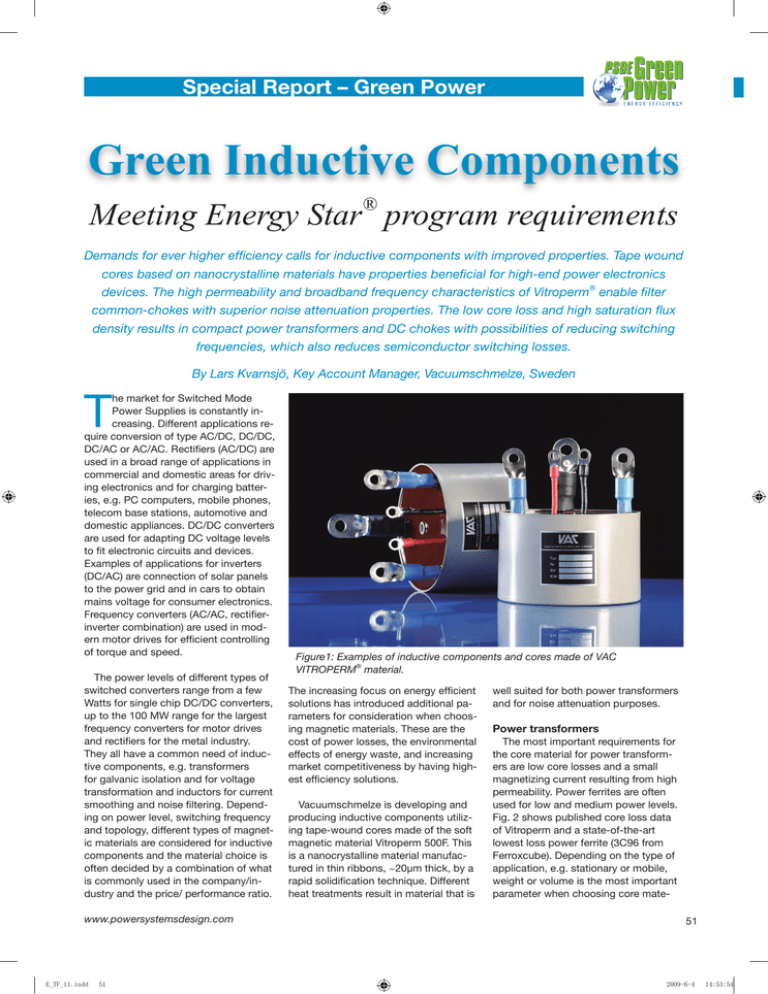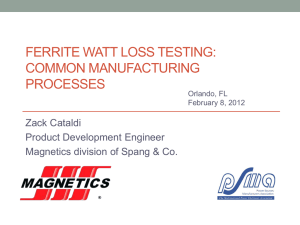Document
advertisement

Special Report – Green PowerPower Special Report – Green Green Inductive Components Meeting Energy Star® program requirements Demands for ever higher efficiency calls for inductive components with improved properties. Tape wound cores based on nanocrystalline materials have properties beneficial for high-end power electronics devices. The high permeability and broadband frequency characteristics of Vitroperm® enable filter common-chokes with superior noise attenuation properties. The low core loss and high saturation flux density results in compact power transformers and DC chokes with possibilities of reducing switching frequencies, which also reduces semiconductor switching losses. By Lars Kvarnsjö, Key Account Manager, Vacuumschmelze, Sweden T he market for Switched Mode Power Supplies is constantly increasing. Different applications require conversion of type AC/DC, DC/DC, DC/AC or AC/AC. Rectifiers (AC/DC) are used in a broad range of applications in commercial and domestic areas for driving electronics and for charging batteries, e.g. PC computers, mobile phones, telecom base stations, automotive and domestic appliances. DC/DC converters are used for adapting DC voltage levels to fit electronic circuits and devices. Examples of applications for inverters (DC/AC) are connection of solar panels to the power grid and in cars to obtain mains voltage for consumer electronics. Frequency converters (AC/AC, rectifierinverter combination) are used in modern motor drives for efficient controlling of torque and speed. The power levels of different types of switched converters range from a few Watts for single chip DC/DC converters, up to the 100 MW range for the largest frequency converters for motor drives and rectifiers for the metal industry. They all have a common need of inductive components, e.g. transformers for galvanic isolation and for voltage transformation and inductors for current smoothing and noise filtering. Depending on power level, switching frequency and topology, different types of magnetic materials are considered for inductive components and the material choice is often decided by a combination of what is commonly used in the company/industry and the price/ performance ratio. www.powersystemsdesign.com E_TF_11.indd 51 Figure1: Examples of inductive components and cores made of VAC VITROPERM® material. The increasing focus on energy efficient solutions has introduced additional parameters for consideration when choosing magnetic materials. These are the cost of power losses, the environmental effects of energy waste, and increasing market competitiveness by having highest efficiency solutions. Vacuumschmelze is developing and producing inductive components utilizing tape-wound cores made of the soft magnetic material Vitroperm 500F. This is a nanocrystalline material manufactured in thin ribbons, ~20µm thick, by a rapid solidification technique. Different heat treatments result in material that is well suited for both power transformers and for noise attenuation purposes. Power transformers The most important requirements for the core material for power transformers are low core losses and a small magnetizing current resulting from high permeability. Power ferrites are often used for low and medium power levels. Fig. 2 shows published core loss data of Vitroperm and a state-of-the-art lowest loss power ferrite (3C96 from Ferroxcube). Depending on the type of application, e.g. stationary or mobile, weight or volume is the most important parameter when choosing core mate51 2009-6-4 14:53:54 Special Report – Green Power Common-mode chokes All switched converters generate noise that has to be suppressed to fulfill EMC standards for the different application fields. The noise is separated into conducted and radiated noise. Conducted noise is differentiated into differential mode (DM) and common mode (CM). Attenuation of common mode noise can be done with common-mode chokes (CMC’s) and 1 100 kHz 50 kHz 25 kHz 100 10000 B (mT) 1000 100 10 100 kHz 50 kHz 25 kHz 1 50 1100 00 200 500 B (mT) Figure2: Published core losses of Ferroxcube 3C96, VAC Vitroperm® and Metglas 2606SA1. 700.00 3C96 Vitroperm® 600.00 500.00 400.00 f = 50 kHz B = 200 mT 300.00 200.00 100.00 0.00 50 70 90 110 130 150 52 170 Core temperature (°C) Figure3: Core losses of Ferroxcube 3C96 and VAC Vitroperm® as function of temperature. Power Systems Design Europe 52 E_TF_11.indd 10 0,1 Core losses (kW/m3) At higher power levels it can be difficult to achieve reasonable designs with powder cores. In comparison to Vitroperm the core losses of different types of powder10 cores, e.g. Sendust, MPP, High-Flux, iron-based amorphous and iron powder are about 10 times higher or even more. In order to keep the AC flux and hence core losses at a reasonable 1 level, a high number of turns is needed. On the other hand 1this 0 action causes an increase of the copper losses. A gapped-core design with a low loss core material, such as Vitroperm will automatically lead to a more energy efficient solution. Due to the extremely low core losses and high saturation flux density, compact inductor designs can be realized. For these a high ripple current (high flux ripple) can be allowed without leading to excessive heating. Because of their very high saturation flux density, tape wound cores made of iron-based amorphous material, such as Metglas 2605SA1, are also sometimes used in high frequency high power DC and PFC chokes. The published core loss data of 2605SA1, though, given in Fig. 2, shows that core losses of iron-based amorphous cores are an order of magnitude higher than those of nanocrystalline cores. Another significant property of Vitroperm is the magnetostriction of around zero (1∙10-7). Compared with the high values of iron based amorphous material (27∙10-6), you get no disturbing noises in low frequency applications (f ≤ 16 kHz). Taking all aspects into account, the high saturation flux density and the low core losses of Vitroperm make it an optimum choice for energy efficient designs of high power DC and PFC chokes. SA1 100 Core losses (kW/m3) 3C96@25kHz VP500F@25kHz DC and PFC chokes bear a DC or low frequency current SA1@25kHz with a superposed high frequency current ripple. For low powSA1@50kHz 100 er switched converters toroidal powder cores are often used. SA1@100kHz VITROPERM 1000 1 As shown in Fig. 3 the core losses of Vitroperm are stable over the whole active temperature range, with the core loss temperature coefficient even being slightly negative. This im0.1 plies that inductive component designs with these cores have optimum energy efficiency over the whole1load and opera0 10000 tional temperature range. The stable core losses of 3C96@100kHz Vitroperm with respect to temperature also ensure a robust design with VP500F@100kHz 3C96@50kHz no risk for positive feedback of temperature. VP500F@50kHz 1000 DC and PFC chokes ® 3C96 Core losses (W/kg) Core losses (W/kg) rial. Therefore the typical core losses are shown comparing per unit weight and per unit volume. At magnetization levels > 1000 3C96@100kHz 100 mT and switching frequencies <100 kHz Vitroperm is the VP500F@100kHz optimum choice in terms of core losses. Another important parameter to consider is the much higher magnetic3C96@50kHz saturation VP500F@50kHz 100of power ferrites. level of Vitroperm in comparison to that At 3C96@25kHz switching frequencies ≤ 40 kHz ferrite core power transformVP500F@25kHz ers are not loss limited but flux limited, leading to bulky and SA1@25kHz heavy designs. More compact and energy efficient designs SA1@50kHz 10 can be obtained using a nanocrystalline core. Typical fields of SA1@100kHz application for this are traction and welding. June 2009 2009-6-4 14:53:58 Special Report – Green Power Y-capacitors (Cy). ferrite data books. Vitroperm is stable over the whole temperature range. Vitroperm is proven to be an excellent core material for CMC’s. The upper part of Fig. 4a shows the absolute value of the complex permeability |µ| as function of frequency. This typical characteristic of Vitroperm is compared with some well-known state-of the-art EMI ferrites: Ferroxcube 3E5 and 3E25 and Epcos T38 and T65. The complex permeability is a combination of the inductive and the resistive part, defined as µ = µ’ - jµ’’. For ferrites, µ’ and µ’’ are found in most Vitroperm has higher permeability over the whole frequency range compared to ferrite CMC materials, and a detailed view will show that this holds for both µ’ and µ’’. Two additional properties should be mentioned: a) the negative slope of |µ (f)| at higher frequencies is not so steep for Vitroperm as for ferrites, implying wide band suppression of chokes with a Vitroperm core, and b) the permeability of ferrites varies significantly over temperature while the permeability of Comparison VITROPERM - ferrite, CMC 16A, 30×20×10mm³, 2×14 turns, 1.6mm 1000000 ® VITROPERM 100000 |µ| 10000 Ferrites 1000 100 10 100000 Simul. 6123X616: Core VP500F (30×20×10mm³), 2×14 turns (1.6mm), L(10kHz)=13mH, L(100kHz)=2.7mH Simul. 3 E5(1): Core Ferroxcube 3E5, 20°C (30×20×10mm³), 2×14 turns (1.6mm), L(10kHz)=1.3mH, L(100kHz)=1.3mH Simul. 3 E5(2): Core Ferroxcube 3E5, 80°C (30×20×10mm³), 2×14 turns (1.6mm), L(10kHz)=1.3mH, L(100kHz)=1.1mH Simul. 3 E25: Core Ferroxcube 3E25, 80°C (30×20×10mm³), 2×14 turns (1.6mm), L(10kHz)=1.2mH, L(100kHz)=1mH Simul. T65: Core EPCOS T65, 80°C (30×20×10mm³), 2×14 turns (1.6mm), L(10kHz)=0.82mH, L(100kHz)=0.79mH Simul. T38: Core EPCOS T38, 80°C (30×20×10mm³), 2×14 turns (1.6mm), L(10kHz)=1.6mH, L(100kHz)=1.3mH Sample 5-R6123-X616 (measurement) Impedance |Z| [Ω ] 10000 ® VITROPERM 1000 Ferrites 100 10 0,001 0,01 0,1 1 10 100 1000 Frequency [MHz] ® ® different ferrite Figure4: Fig. Vitroperm 4:VITROPERM and and different ferrite grades.grades. a) Absolute permeability and a) Absolute permeability. b) simulated CMC impedance b) Simulated CMC impedance. VAC VITROPERM® 500F (power and noise) Ferroxcube 3C96 (power) Metglas 2605SA1 (power) Ferroxcube 3E5 (noise) 1,2 0,44 1,56 0,23 ∼ 15000 - 100000 2000 - 10000 90 140 1000 - Saturation flux density (T) 100oC Permeability 25oC Typical losses PFe (mW/cm³) 50kHz, 200 mT, 100oC Table 1: Comparison of soft magnetic core materials for power and noise suppression applications. www.powersystemsdesign.com E_TF_11.indd 53 A CMC with the highest impedance is of interest for a filter design since this blocks the noise path most effectively. Fig. 4b shows an example of simulated impedances of a 2x14 turns 16 A CMC. The different characteristics correspond to CMCs with cores of the different materials from Fig. 4a. The CMC with a Vitroperm core has the highest impedance. In real designs, often a specific impedance is required in order to fulfill the EMI standard. In such case a CMC with a Vitroperm core can have a smaller core and/or fewer turns than a corresponding CMC with a ferrite core. This implies that the Vitroperm design will be more energy efficient since smaller values for the DC resistance are possible, and hence the normal conduction losses will be smaller. Vitroperm CMC’s also allow good possibilities of reducing 2-stage ferrite filter designs to 1-stage Vitroperm designs. A single phase CMC contains two windings, wound in a way that the normal load current is compensated. Therefore no magnetic flux is generated in the core. The magnetic flux leakage however will cross the core between the two windings with a risk of local saturation, which disables the function of the CMC completely. Due to the better conduction of the magnetic flux (high permeability) and the 3 times higher saturation flux density; this risk is smaller for Vitroperm cores in comparison to ferrite cores. For applications with large unbalanced currents, e.g. for motor drives with long cables or for attenuation of bearing currents, VAC has invented an alternative grade: Vitroperm 250F. This material has the same high saturation flux density as Vitroperm 500F (1.2T), but with a permeability in the range of 5000, similar to typical EMI ferrites, and therefore in comparison, its resistance against saturation effects is three times higher. Designing inductive components for power electronics with nanocrystalline magnetic cores will help significantly to increase the overall efficiency of power supplies. www.vacuumschmelze.de 53 2009-6-4 14:54:02


